Let’s paint a picture. It’s 3 PM. You’ve been staring at a screen for hours, and you can feel it—that familiar ache creeping into your lower back, your shoulders rounding forward into a permanent slump, and your neck carrying the weight of the world. By the end of the day, your posture looks more like a question mark than an exclamation point.
If your desk job is turning your spine into your own worst enemy, you are not alone. Our bodies weren’t designed for eight hours of sitting, and they often protest with stiffness, pain, and poor posture.
But what can you do? You can’t exactly roll out a yoga mat next to the printer.
The good news is, you don’t have to. We’ve compiled seven physiotherapist-approved, incredibly discreet stretches you can do right in your office chair. These aren’t big, dramatic movements; they are subtle, effective adjustments that will release tension, realign your spine, and fix your posture—all without drawing the attention of your boss.
Why Your Desk Is a Posture Nightmare
Before we dive in, let’s quickly understand the enemy. Constant sitting shortens your hip flexors, tightens your chest muscles, and weakens your upper back muscles. This muscular imbalance pulls your body forward into that classic “desk slump,” leading to everything from headaches and neck pain to chronic lower back issues. These stretches are designed to specifically counteract that pull.
The 7 Discreet Stretches to Reclaim Your Spine
1. The Subtle Neck Tilt
This is the perfect antidote to “tech neck,” the strain caused by looking down at screens. It gently releases the tight levator scapulae and scalene muscles on the side of your neck.

How to do it:
- Sit tall in your chair, feet flat on the floor.
- Gently tilt your right ear toward your right shoulder, keeping the left shoulder down and relaxed.
- Hold for 15-20 seconds, feeling a gentle stretch along the left side of your neck.
- Slowly return to the center and repeat on the other side.
Why it Works: It directly lengthens the neck muscles that become tight and shortened from looking at monitors.
Pro-Tip: Don’t pull your head down with your hand. Let the weight of your head do the work for a safer, more effective stretch.
2. The “Invisible” Shoulder Blade Squeeze
This is your secret weapon against rounded, hunched shoulders. It activates the weak muscles in your upper back (the rhomboids and middle trapezius) that are crucial for good posture.
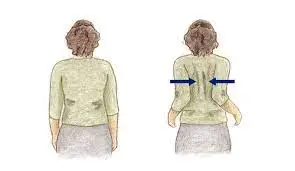
How to do it:
- Sit tall with your arms resting comfortably at your sides.
- Imagine you’re trying to crack a nut between your shoulder blades. Gently squeeze them together and down.
- Hold for 5-10 seconds, then release.
- Repeat 10 times.
Why it Works: It strengthens the muscles responsible for pulling your shoulders back and down, counteracting the forward slump.
Pro-Tip: Avoid shrugging your shoulders up towards your ears. The movement should be backward and downward.
3. The Upper Back Stretch (The Desk Hug)
After squeezing, you need to release. This stretch targets the upper back and the area between your shoulder blades.
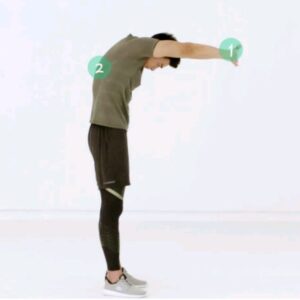
How to do it:
- Clasp your hands together in front of you.
- Push your hands away from your body, allowing your upper back to round naturally.
- Tuck your chin to your chest and feel the stretch between your shoulder blades.
- Hold for 15-20 seconds while breathing deeply.
Why it Works: It stretches the rhomboids and trapezius muscles, relieving tension that builds up from holding a static posture.
4. The Seated Spinal Twist
Sitting stagnates the spine. A gentle twist is like a refreshing drink of water for your vertebrae, improving mobility and relieving stiffness.
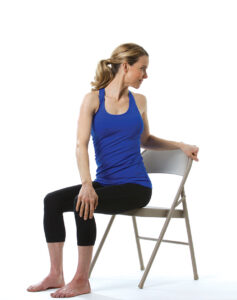
How to do it:
- Sit tall with your feet flat on the floor.
- Place your left hand on your right knee. Place your right hand on the armrest or back of your chair.
- Gently twist your upper body to the right, using your hands as gentle levers.
- Hold for 15-20 seconds, then slowly return to center and repeat on the left side.
Why it Works: It mobilizes the thoracic spine (mid-back), which often becomes rigid from sitting.
5. The Wrist and Finger Extensor Stretch
Hours of typing and mouse-clicking can lead to serious wrist and forearm strain. This simple stretch is a must-do.
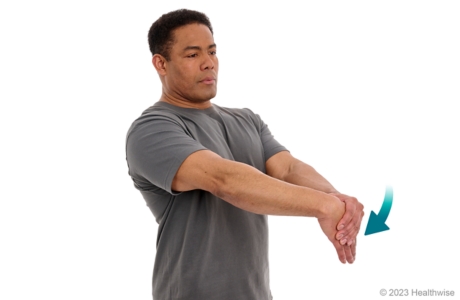
How to do it:
- Extend your right arm in front of you, palm down.
- Gently bend your wrist down with your left hand until you feel a stretch in your forearm.
- Hold for 15 seconds.
- Now, flip your hand so your palm faces up and gently pull your fingers back toward your body. Hold for 15 seconds.
- Repeat on the left arm.
Why it Works: It prevents repetitive strain injuries by lengthening the forearm muscles that control your fingers and wrist.
6. The Seated Figure-Four Stretch
Your hips and glutes get incredibly tight from sitting. This tension can pull on your lower back and even contribute to sciatica.
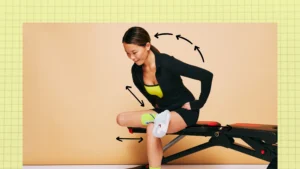
How to do it:
- While seated, cross your right ankle over your left knee.
- Sit up tall and, if you need a deeper stretch, gently press down on your right knee or lean your torso forward with a flat back.
- You should feel a stretch deep in your right glute and hip.
- Hold for 20-30 seconds and switch sides.
Why it Works: It stretches the piriformis and other deep gluteal muscles, which can alleviate lower back pain and sciatica symptoms.
7. The Chair Chest Opener
This is the ultimate counter-pose to slouching. It opens up your chest and fronts of your shoulders.
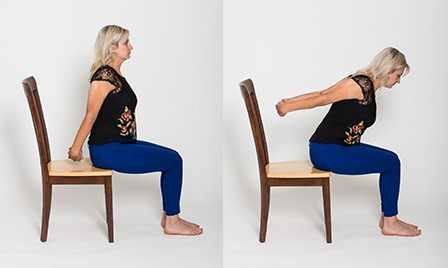
How to do it:
- Sit on the edge of your chair.
- Reach both hands behind you and clasp the back of your chair, or interlace your fingers.
- Roll your shoulders back and down, squeeze your shoulder blades, and lift your chest.
- Hold for 15-20 seconds while breathing deeply into your chest.
Why it Works: It stretches the tight pectoral muscles that pull your shoulders forward, allowing you to sit more upright naturally.
Conclusion: Small Habits, Big Posture Results
You don’t need to overhaul your entire workday to save your spine. By sprinkling these seven micro-stretches throughout your day—a neck tilt during a phone call, a shoulder squeeze while reading an email—you are actively fighting the negative effects of sitting.
Consistency is key. Make these movements a habit, and in just a week, you’ll notice less stiffness, reduced pain, and a posture that feels stronger and more aligned.
Ready to address the root cause of your posture problems with a personalized program? Visit physiogain to book a virtual posture assessment with one of our expert physiotherapists. Let’s build a stronger, healthier you, one stretch at a time!
Which of these stretches are you going to try first? Let us know in the comments below!